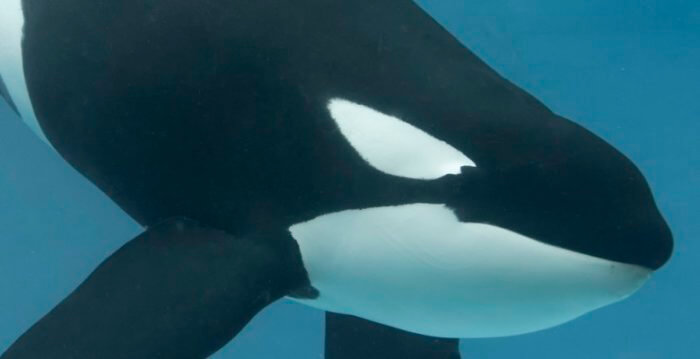Keet: Shipped Around the Country

Timid and passive, Keet tends to remove himself from any problems within his social group. He prefers to be left alone, and if conflict arises among his tankmates, he tries to extricate himself from the environment.
Yet this 8,000-pound male killer whale has enjoyed anything but a life without conflict. Keet’s personal history testifies to the terrible stressors experienced by orcas in captivity, stressors that have fundamentally shaped his behavior and personality.
He was born in SeaWorld’s San Antonio facility in February 1993 to Kalina, then a first-time mother. Kalina, herself an orca born in captivity, gained the dubious honor of giving birth to the first second-generation captive-born orca: Keet. For SeaWorld, his birth certainly did not merit any out-of-the ordinary privileges. Indeed, young Keet soon became subject to the cruel, family-wrecking treatment endured by many individuals in the company’s “collection.”
When Keet was only 20 months old and was still nursing, SeaWorld shipped his mother to another facility. The company claims that they do not and have never separated mothers and calves if the youngsters are not yet weaned. But former orca trainer John Hargrove has testified at legal and legislative proceedings that Keet was still actively and regularly nursing – coming up to the surface with milk in his mouth – when they took Kalina away from him.
Sometimes his whole body would tremble from being raked by his tankmates.
The trauma involved in this separation cannot be overstated. In the wild, whale moms and their male children spend their entire lives together. In Keet’s case, separation from Kalina meant that the other San Antonio whales had to sort Keet into their social order without the guiding influence of his mother and protector.
Stress, confusion and abuse ensued. When he was only a year and a half old, Keet began to endure harassment from fellow orcas Haida and Ky, harassment that would physically and psychologically scar him for life. Keet began throwing up his food and breaking away from his trainers to avoid being close to these whales. Sometimes his whole body would tremble from the anguish of being viciously raked by his tankmates.
SeaWorld documented this ongoing abuse, yet still they kept Keet housed with his tormentors for five agonizing years. Then the trauma of cross-country moves began. In 1999, he was shipped to California. The following year, to Ohio. A year later, he went back to California. Each time, he had to be hoisted out of a pool, packed into a truck, and thrust into a tiny tank with whales who already belonged to a social order that did not include him.
In 2004, Keet would be moved again to San Antonio, and in 2012, he was sent to his present location in San Diego. With all these moves and all the abuse he has endured, we wonder if Keet has ever felt at home anywhere. All in all, he’s been moved around more than any other living whale in SeaWorld’s collection.
Keet’s situation in San Diego continues to be injurious to him. His dorsal fin has collapsed and part of it seems to be rotting away. And now he’s been enduring laser treatments that are apparently designed to cauterize the rotting flesh of the fin. On top of that, it looks like his tankmates are ripping chunks of flesh from the area of his fin.
Video by CetusCetus of trainers treating the trailing edge of Keet’s dorsal fin. (Audio is of a visitor and family.)
Experts think that the state of Keet’s dorsal fin shows that he may be suffering from a viral or bacterial infection, or that his tankmates are once again ripping chunks out of his body with their teeth. Dr. Naomi Rose, who was at that time senior scientist at Humane Society International, told TakePart: “It sure does look like someone has been chewing on” Keet’s dorsal fin.
Former trainer Hargrove notes that when he was working at SeaWorld, staff members had noticed that a piece of his dorsal fin was coming off and that the other whales were chewing on it and attempting to bite it off. The staff members were speculating that since Keet had always avoided getting into altercations with his tankmates, they weren’t attacking him but rather trying to rid him of the infected area.
Keet remains a submissive whale. Who can blame him? After the life of harassment and stress he has endured, hiding from additional conflict seems like his only option. Except, there’s no place to hide from stress when you live in captivity.
What if Keet didn’t need to hide anymore? What if he could live without fear? A seaside sanctuary could provide him with such a life. There, he could find his true home – a place to feel free from worry. Keet could find a place to finally know peace.